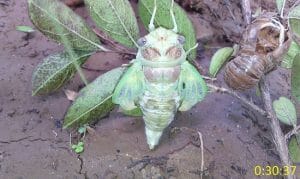Ecdysis Definition
Ecdysis comes from the Greek word ekdusis, which means “put off.” It describes the process by which arthropods and insects shed their outer cuticle (exoskeleton), or how reptiles shed their old skin. This process is necessary in order for the organism to grow. The term for the cuticle or skin that is lost is exuviae. This is another Greek word and it means “things stripped from the body.”
The Ecdysis Process
Ecdysis in arthropods occurs after a series of steps that are mediated by a hormone called ecdysone that is secreted from glands behind the brain. This hormone has three functions. It causes the cuticle to separate from the skin underneath, causes the secretion of new cuticle material in the skin and it starts the breakdown of the old cuticle. Organisms use up a lot of energy while making a new cuticle. They reduce the amount of new energy needed for the process by breaking down and recycling the materials from the old cuticle. Ecdysis is the moment when this process is complete, and the old cuticle starts to come off. The new cuticle is initially very soft, but hardens in a few hours.
Ecdysis is a different process in reptiles. Snakes lose their entire skin in one piece, while a lizard’s skin peels off in small sections. When a snake is ready to shed its skin, it said to be “in the blue.” This is because its eyes become cloudy or “bluish,” its skin becomes dull, and it starts to act nervously. A snake starts the shedding process at its nose by rubbing against rocks and branches. Over the course of 1-2 weeks, this process continues, ending at the tail.

The image above shows a cicada (left) that has shed its outer cuticle (right).
Quiz
1. Which of the following is NOT a function of the hormone ecdysone?
A. Hardening the new cuticle material.
B. Causing the old cuticle separate from the skin.
C. Causing the secretion of new cuticle material.
D. Breaking down the old cuticle.
References
- Ecdysis. (n.d.). In Oxford Dictionaries.com. Retrieved from https://en.oxforddictionaries.com/definition/ecdysis.
- Ecdysis. (2017, May 15). Retrieved from https://www.revolvy.com/topic/Ecdysis&item_type=topic.
- Exuviae. (2017, May 15). Retrieved from https://www.revolvy.com/topic/Exuvia&item_type=topic.
- Molting. (n.d.). In Encyclopedia.com. Retrieved from http://www.encyclopedia.com/plants-and-animals/zoology-and-veterinary-medicine/zoology-general/molting.
- Snake shedding: Ecdysis and dysecdysis. (2017, May 15). Retrieved from http://www.peteducation.com/article.cfm?c=17+1831&aid=1648.
